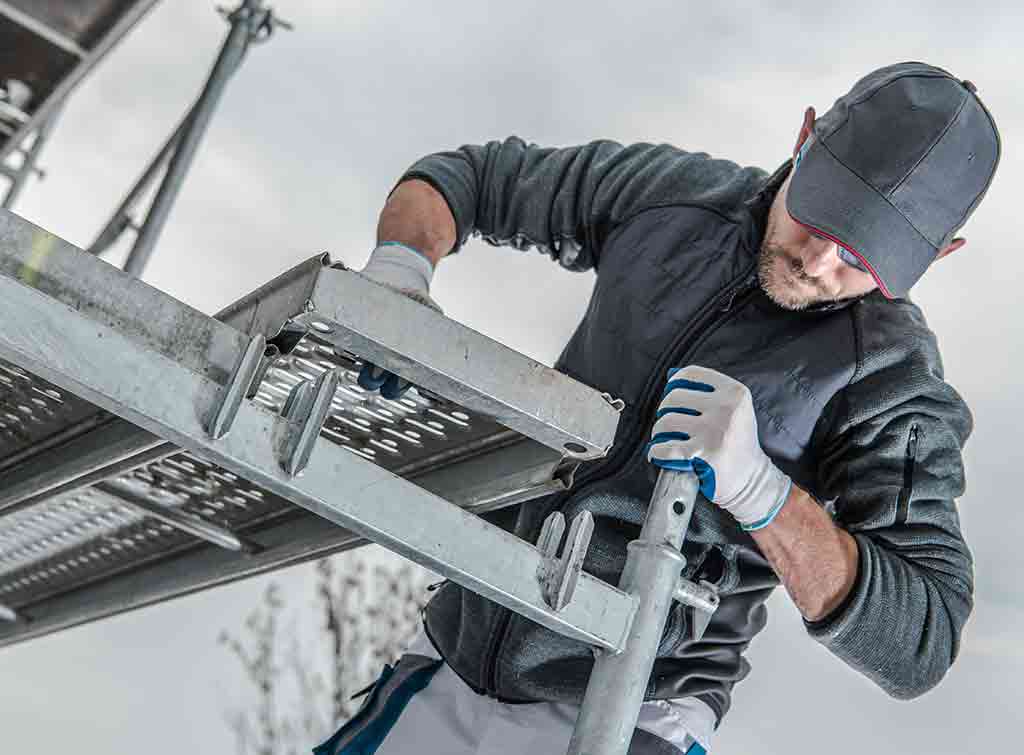How to start a scaffolding company

In this article, we'll cover:
- Why start a scaffolding business?
- Creating a scaffolding business plan
- What qualifications are needed for scaffolding?
- What important skills do scaffolders need?
- How to start a scaffolding business
- Important scaffolding licences and permits
- How to grow a scaffolding business
- How to get more scaffolding work
- Market your new business with Checkatrade
- Scaffolding business FAQs
Why start a scaffolding business?
Necessary on almost every construction project out there, knowing how to erect scaffolding correctly is a sought-after skill. And the market for such business has only increased in recent years thanks to construction projects becoming more ambitious.
Naturally, the demand for higher and larger buildings that require the use of scaffolding isn’t going away. This makes starting a scaffolding business in the UK an excellent idea for anyone who wants steady trade work.
But there’s more benefits to setting up a scaffolding business besides regular customers, namely becoming your own boss.
So, whether you’ve been working in the industry for some time now, or you’re completely new, take a look at our guide to see what’s involved in setting up a scaffolding business of your own.
Creating a scaffolding business plan
The start of any successful business always begins with creating a bulletproof business plan.
It’s absolutely essential you give your business as many advantages as possible when first starting out. And a good business plan is going to ensure you avoid many of the common startup mistakes.
To start with, you’ll want to lay out your business’s goals, and the steps you’ll take to achieve them.
Goals setting is very important for keeping your business vision in mind.
They’ll ensure you stay focused, organised, efficient, and productive. All of which will make it much easier for you to deliver informed business decisions.
So, when creating your goals, keep in mind the following areas:
- Your business goals – the main aims of your business and how you want to reach them
- Startup costs – what areas of finance you plan to use to finance your business initially
- Finance management – whether or not you will manage your finances or an accountant
- Your services – what sorts of scaffolding areas you’ll be focusing on when advertising your company
- Your target market – what areas of scaffolding you’ll specialise in, such as the domestic or commercial sectors
- Your prices – how much you intend to charge for your services, depending on what’s required of a job
- Your area of operation – the scope of the area you plan to operate in
- Types of marketing – what marketing areas you plan to focus on
- Your working hours – when you plan to work, including whether or not you intend to work weekends
Once you’ve considered these, you’ll have plenty of information on hand to bring your business plan to life. But if you want more information and help on this, you can read our price on writing a business plan. We also have a free business plan template you can use as well.

What qualifications are needed for scaffolding?
Like many other trades, there are a variety of training methods you can take to become a scaffolder. Most people choose to be trained on the job through an apprenticeship provided by a company or college.
Most scaffolders will take a one-day course initially, and then further training after six months. This is often in the form of two ten-day programmes and a practical evaluation of your skills. Once complete, you’ll then have a final assessment.
With this in mind, you might be surprised at how easy it is to become a scaffolder. However, due to its nature, the main challenge in starting a scaffolding business in the UK is learning all the required regulations.
Scaffolding health and safety regulations
As you no doubt know, scaffolding comes with many dangerous risks. This means that health and safety needs to be taken very seriously.
As a business owner, you’ll need to know the Health and Safety Executive guidance inside out. That way, you can mitigate any risk to your team and the public while working.
For more information on this, you should read our articles on working at heights and scaffolding health and safety.
Construction Skills Certificate Scheme (CSCS)
Besides getting qualified and learning health and safety guidelines, you’ll also need to become CSCS certified.
As a scaffolder, you’ll be working on construction sites, which means you need a CSCS card to legally take these jobs. If you’re not, you’ll end up having to pass up several jobs.

What important skills do scaffolders need?
Although experience and industry knowledge are essential for starting your own scaffolding business, so are soft skills.
These sorts of skills include areas crucial to business management and will be essential to your success.
The following are all good skills to practice before becoming a business owner:
- Construction knowledge – it goes without saying that good construction knowledge will be invaluable when building scaffolding
- Attention to detail – attention to detail is vital to making sure your scaffolding is built correctly
- Organisation – you’ll be managing a lot of different elements in a scaffolding business, including business finances and material supplies
- Interpersonal skills – as a scaffolder, you’ll also be working with other tradespeople in your projects, so you need to be able to work smoothly with them
- Leadership skills – scaffolding is not a one-person job, which means you’ll need to hire other people on your team that you’ll be in charge of
- Patience – not every job will be easy, and having patience is vital to avoid building mistakes
- Enthusiasm and endurance – as a scaffolder, you’ll have to work on all manner of lengthy projects, sometimes in bad weather, so enthusiasm and endurance are very important
- Numeracy skills – from measuring building heights to sorting out your business finances, good numeracy skills are always useful to have
Of course, there are plenty of other soft skills you can look into training in. We suggest reading our piece on becoming your own boss to learn more.
How to start a scaffolding business
With the initial information on how to start a scaffolding business covered, let’s look at the first steps to take.
This will cover everything from naming and registering your business to the licenses and permits you need to get started.
1. Registering your business
When starting any company, the first two things you’ll need to do is name and register your company.
Registering your company, in particular, is very important. As you’ll need to decide between being a sole trader or a limited company.
We’d recommend doing as much research as possible on these areas as possible, as they operate quite differently. Each also comes with their own unique advantages and disadvantages that you should be aware of.
2. Applying for scaffolding insurance
Any tradesperson needs to have insurance to protect their business on a legal and financial level. For example, all Checkatrade members are required to have public liability insurance.
This is even more important for scaffolding due to the work involved. We suggest investing in all of the following insurance areas to cover all your bases:
- Public liability insurance – to protect yourself from any accidental damage you do to a client’s property
- Professional indemnity insurance – for financial protection should someone try to slander your company’s reputation
- Tools insurance – to replace any tools or equipment that’s stolen or damaged on the job
- Employer’s liability insurance – to cover your employee’s finances if they’re injured while working. As an employer, this is a legal requirement
With these policies, we also suggest speaking with an expert to merge them into one packet.
This will make it easier to manage financially. For more information on insurance, you can also read our article on picking the right tradesperson insurance. As well as our piece on scaffolding insurance.
3. Accounting and bookkeeping
If you plan to start your own business, one key area you need knowledge in is accounting and bookkeeping. You’ll need to know how much you’ll need to start your business and your potential overheads.
You’ll also need to be organised with your accounting and bookkeeping. This means keeping records of business expenses and invoices so you know your in-goings and outgoings.
Take a look at our small business accounting article for more information.
4. Buying your scaffolding tools and equipment
Finally, with the previous three points covered, you can now look at buying your scaffolding tools and equipment. This, of course, means buying the scaffolding itself, but you’ll also want to invest in all the gear below:
- PPE
- Safety harnesses and lanyards
- Spirit levels
- Claw hammer
- Tape measure
- Socket set
- Scaffolders wrench
You’ll naturally also need some form of transport vehicle on top of these to move all your materials.
Our article on van lease details covers this in more detail. And don’t forget that Checkatrade members get discounts on any tools and equipment they buy.
More than just a directory listing
Receive help, support, advice and a range of money-saving discounts to help make your business a success
Important scaffolding licences and permits
As we’ve already mentioned, scaffolders are legally required to have certain licenses in order to operate.
These may include public highway licences, local authority licences and goods vehicle operator licences, to name a few.
You should speak to your local council to learn more about the ones your business might need.
How to get a scaffolding licence
To apply for a scaffolding license, you need to visit the UK government licence finder website.
Here you can enter the postcode of where you’ll be carrying out the work. You’ll then be able to apply for a permit from the local council in charge of the area.
It’s always best to complete your application at least 15 working days ahead of the start date for your project.
This allows time for everything to be processed. Sometimes, a site visit might be required as part of your application. So, you’ll need to leave time for this to be carried out too.
Scaffolding licence requirements
When applying for a scaffolding license, there are several requirements to keep in mind. These can include all or some of the following:
- Provision of a site plan
- Supplying a risk assessment
- Writing out a method statement
- Having public liability insurance that covers a minimum of five million pounds
Your risk assessment, in particular, should also provide a detailed overview of:
- Any potential site hazards
- A list of who could be harmed, and how
- An evaluation of the risks and precautions you’ve identified
As for your method statement, you should cover how you’re going to control the health and safety risks you’ve outlined.
As an aside, most councils usually issue a scaffolding licence for a certain period of time. If you find your project taking longer, you’ll have to apply for another permit later down the line.
Are there rules for scaffolding permits?
Once you’ve obtained your licence, there are a few regulations you should be aware of so you can follow best practice:
- Scaffolding should be well-lit during dark hours
- If requested by environmental services, you’ll need to have a covered footway and handrail put in place for pedestrians
- The name of your business and your contact number should be displayed on the scaffolding at all times
- When removing scaffolding, make sure all debris and waste materials are cleared away, or you could face cleaning costs from the local council
- A copy of your licence must be clearly displayed on the scaffolding at all times
Scaffolding pavement licence cost
All scaffolding licences require a submission fee that you’ll have to pay before they’re granted.
This price will vary from council to council and will depend on the length of the scaffolding and the time period. Here’s a rough breakdown of the costs:
- A one-month licence for scaffolding that’s 10 metres or less will cost between £200 and £300
- Scaffolding measuring more than 10 metres will cost between £300 and £600
Fortunately, if you do have to renew your scaffolding permit, some councils will offer an extension discount.
In some instances, you can also join a council’s scaffolding register for the year for reduced prices on your permits.
How to grow a scaffolding business
With the opening steps of setting up a scaffolding business covered, we’ll now turn to how you can grow your business. This includes areas such as scaling the size of your business, as well as your marketing strategy.
1. Scaling your business
Eventually, every business will look to grow in order to bring in more leads. This in turn means that you’ll need to scale your operation appropriately.
As a result, you’ll need to readjust your business plan to accommodate these changes. After all, if you can’t meet your new growth demands, your business might fail.
In order to keep this growth steady, rather than letting it overwhelm you, you should scale in the following areas:
- Business streaming – to grow effectively, your business needs to operate seamlessly. Be sure to check that all areas of your business are working properly together before you start expanding outwards
- Financial stability – it’s safe to say that true growth can’t be achieved without good finances. If you don’t have savings in place to cover your growth, make sure you research other areas of finance that you could use
- Quality consistency – one key thing you don’t want to lose when growing is the quality of your work. Always make sure that you’re growing at a rate where your current work quality can be properly maintained
- Team growth – while all scaffolding businesses need multiple people to run efficiently, eventually, you will need to expand your team. Be sure to vet your new staff properly to ensure they meet your business values and expectations
2. Digitally marketing your business
Any business can benefit massively from good digital marketing preparation. This means a large portion of your marketing budget should be directed towards this to cover all areas below:
- Building a website – there are very few businesses today that operate without a website. This makes it crucial for you to build yours and ensure it functions correctly. We cover all this in great detail in our small website article
- Using social media – while not something you commonly associate with scaffolding, by using social media, you can get your brand out there. Again, you can find plenty of info on this in our piece on social media marketing
- Joining an online directory – plenty of customers still use online directories to find reputable tradespeople, including Checkatrade. Get in touch with our team today to find out how our directory could help your marketing
3. Advertising your scaffolding business
While online marketing is useful for scaffolding businesses, traditional advertising is where you can really excel with your marketing budget. We suggest using all of these methods below to get the most out of your marketing plan:
- Print media – despite what you might have heard, print media remains a powerful tool in your marketing repertoire. Read our print marketing guide to learn how to use it effectively
- PPC – pay-per-click advertising is one of the best ways to prominently position your company on Google through search results advertising. If you want to know more about this marketing aspect, we suggest reaching out to a PPC expert near you
- Company signage – company branding is a tried and true method of physical advertising and is one of the best tools at a scaffolder’s disposal. Your name will already be prominently displayed on your scaffolding, but you can take it one step further by branding both your vehicles and your work uniform
- Event sponsorship – if you want to outreach towards your local community, then events sponsorship is a fantastic way to do this, getting your name out there while also putting you in touch with other local businesses
4. Other marketing ideas
Last, but not least, let’s cover three key passive marketing strategies that you can implement to bolster your business marketing:
- Customer reviews – every business, no matter its trade, can benefit from good customer reviews. Make sure to ask your customers to leave one after every project
- Networking – scaffolders tend to work with many other tradespeople, which makes networking invaluable for referral work
- GMB listings – appearing in local searches is always useful for any trade business, so you want to make sure you’re listed on the Google My Business listing as soon as possible to avoid missing lead
You might have guessed that there’s a lot that goes into marketing, which is why we have a free marketing guide you can use.
How to get more scaffolding work
Once you’ve started getting more leads coming in, it’s always good to look into getting more work so you’re never short of jobs.
We suggest looking into the following areas as a means of organically increasing your work volume:
- Further accreditation – while there aren’t many scaffolding qualifications out there, ensuring that you and your team are as qualified as possible will go a long way towards building trust with customers
- Specialised work – you might not think it, but there are many avenues that you can look to specialise towards with your scaffolding work. And by specialising, you can potentially corner a niche in the market
- Repeat business – making sure you leave a good impression on previous clients is more than likely going to encourage them to use your services again
Market your new business with Checkatrade
Hopefully, you should now have a good idea of what’s required to set up a scaffolding business in the UK.
Of course, if you want more help and advice, then you should consider joining Checkatrade.
With our digital marketing strategy and strong online presence, becoming a Checkatrade member makes it easier for customers to find you.
You can display customer reviews, testimonials, and examples of your work on your profile page. You’ll also have access to our community, where you can chat with other members.
Get in touch today to see how we can help your new business.
Scaffolding business FAQs
Do I need a scaffolding licence?
While not necessary for every project, having a license will ensure any work you do is legal. If you continue to operate in this public space without a license, you will likely face legal action and repercussions.
For example, if you’re putting up scaffolding within the boundaries of a property, you don’t need a license. However, this changes if any part of the scaffolding extends onto the pavement or public road outside of the property.
Always take care when beginning a new construction project, and make sure to gain a permit if necessary.
How much does it cost to start a successful scaffolding business?
As with any new business venture, it’s difficult to say how much it will cost to start your scaffolding business. There are many financial costs to consider, including your tools, materials, and equipment, as well as staff.
We suggest researching this topic thoroughly so you can plan accordingly. And if you want to know how much a scaffolder makes, take a look at our piece on scaffolder earnings.










No comments yet!